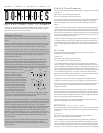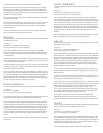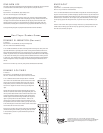to end like the other dominoes. Points are not earned for the matched dominoes.
Matadors are tiles that add up to a sum of seven within themselves (3-4/5-2/6-1, the double
blank 0-0 also counts as a Matador). These dominoes are “wild” and can be played on ANY
END, regardless of which ends are open (it does not have to sum to seven). A Matador tile is
the only tile that may be played on a blank end. The player may decide which end they want to
leave open when they place a Matador.
When a player cannot play, the player draws from the boneyard until they draw a playable tile
or until the boneyard is empty.
ENDING THE GAME: The first player to get rid of all their tiles says, “Domino!” and ends the
round. This player also receives any points left in the other player’s hands. If the round is
blocked, then the player with the lowest pip total wins. The player scores their opponent’s
points minus their own.
After each round, the players’ scores from the previous rounds are added as well. The first
player to reach 100 or more points is the winner of the game.
B E R G E N
In this variation of Block and Draw Dominoes players score points only when the open ends (of
the domino line) are the same.
PLAYERS: 2-4
EQUIPMENT: 1 set of dominoes, paper to keep score
OBJECT: Be the first player to score 15 or more points
PLAY: Shuffle the dominoes; each player draws six tiles. The player with the LOWEST
double starts and also scores 2 points (see Scoring section below), since both open ends are
the same. Play continues clockwise, with each player matching one of the two open ends as
in standard dominoes.
Unlike most domino games, when a player does not have a playable tile, the player only draws
ONE tile from the boneyard. If the tile is playable, it should be placed. If it is not, the player says
“pass” and play continues to the next player.
SCORING: If both open ends are the same (two 6s, two 3s, etc) after a player has placed their
tile, the player scores 2 points. If a player places a double that matches the other open end, the
player scores 3 points for the three matches.
ENDING THE GAME: The first player to get rid of all their tiles says, “Domino!” and earns 1
point for ending the round. If the round is blocked, the player without any doubles in their hand
wins the point. If multiple players have no doubles, the player with the lowest pip total (of their
remaining tiles) wins the point. If multiple players have doubles, the player with the lowest
double wins the point. If no player has reached 15 or more points then another round is played,
and so on. The first player to score 15 or more points is the winner.
B L IN D D O MIN O E S
This is the simplest of all the domino games, in which players do not look at their dominoes.
PLAYERS: 2-5
EQUIPMENT: 1 set of dominoes
OBJECT: Be the first player to get rid of all your dominoes
PLAY: Shuffle the tiles; each player draws a domino until all the dominoes are dealt and each
player has an equal number of tiles. Any remaining dominoes may be set aside.
Players do not look at their hands. They must place their dominoes face down in a horizontal
row, with the long sides facing one another. The youngest player starts by flipping over their
first tile (the domino at the top of the row) and placing it in the center of the playing area. The
next player takes their turn, flipping over the first domino from their row face up. If that domino
matches one of the ends of the central domino it may be played and the player gets another
turn. The player flips up the next domino in the row. If the domino can be played, the player
continues. If the domino cannot be played, then the player moves it to the bottom of their row,
face down. The player’s turn is now over and play continues to the next player in the same
manner.
ENDING THE GAME: The first player to get rid of all of their dominoes calls “Domino!” and
wins the game.
C R O S S D O MIN O E S
This game is played like standard Block and Draw Dominoes except that the first double played
is a spinner.
PLAYERS: 2-4
EQUIPMENT: 1 set of dominoes, paper to keep score
OBJECT: Be the first player to score 100 or more points
PLAY: Shuffle the dominoes; each player draws the same number of tiles, (7 dominoes if 2
players, 5 if 3-4 players). The player with the highest double begins the game. Play continues
clockwise. The first double played is a spinner, which means it must have tiles matched to both
ends and both sides (forming a 5-tile “cross”) before any other tile may be played. If a player
does not have a tile to match to the central tile, they must draw one from the boneyard. If the
tile is playable, they must play it, otherwise the player may say “pass” and the responsibility of
completing the cross passes to the next player. No other tiles may be played until all four cross
tiles have been played. It may take several turns of drawing and passing until the cross is
completed.
Once the central domino has been played on all four sides, then play continues as in standard
Block and Draw Dominoes. (See instructions for Block and Draw Dominoes)
F IVE U P
In this game, players only score if the ends add up to a multiple of five. Also, in this game, every
double played is a possible spinner.
PLAYERS: 2-4
EQUIPMENT: 1 set of dominoes, paper to keep score
OBJECT: Be the first player to score 61 points
PLAY: Shuffle the dominoes; each player draws one domino to determine the first player (the
highest pip total draw). Reshuffle all the tiles and each player draws their hand (7 dominoes if 2
players, 5 if 3-4 players). The first player may place any tile from their hand in the center of the
playing area. Throughout the game after a double is played and another tile has been played on
it, then the double becomes a spinner. The two crosswise ends of the double are now open
ends and may be played on. This means, when all sides of the double have been played on,
players will be adding the value of four open ends to get their score. The rest of the game is
played as standard Block and Draw dominoes.
SCORING: Players earn points ONLY when they make a play that results in the two, three, or
four open ends of the line adding up to a multiple of 5. Although this play is similar, the scoring
differs from All Fives.
The player receives one point for every multiple of five: for example, a sum of 5 pips = 1 point, a
sum of 10 pips = 2 points, a sum of 15 pips = 3 points, and so on. If the sum of the open ends
does not add up to a multiple of five then no points are given.
ENDING THE GAME: The first player to get rid of all their tiles says, “Domino!” and ends the
round. This player also receives any points left in their opponents’ hands (each player sums the
total of their remaining pips and rounds them to the nearest multiple of five and the winner
receives one point for each multiple of 5; 1 or 2 pips = 0 points, 3 to 7 pips = 1 point,
8 to 12 = 2 points, and so on). If the round is blocked, then the player with the lowest pip total
wins. The player scores their opponents’ points minus their own, and rounds the sum to the
nearest multiple of five and is awarded the appropriate point value.
The first player to score EXACTLY 61 POINTS wins the game and the game is ended
immediately. During the round, if a play is made that would cause a player’s total points to
exceed 61, then no points are scored for the particular play and the game continues to the left.
F O U R S
This game is similar to standard Block and Draw Dominoes except that it must be played with 4
players (no teams); players may play multiple dominoes in their turn.
PLAYERS: 4
EQUIPMENT: 1 set of dominoes, paper to keep score
OBJECT: Be the first player to score 100 points
PLAY: Shuffle the dominoes; each player draws one domino to determine the first player (the
highest pip total draw). Reshuffle all the tiles and each player draws their hand of 5 tiles. The
first player may place any tile from their hand in the center of the playing area. If the player has
another domino that is playable, he may place it as well. Play continues clockwise, with each
player placing as many dominoes as possible on their turn.
Scoring and ending the game are played like standard Block and Draw dominoes.





